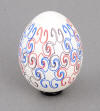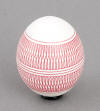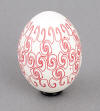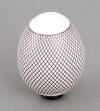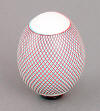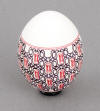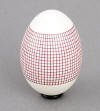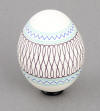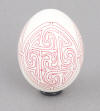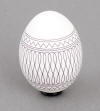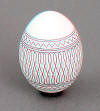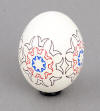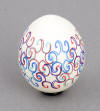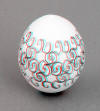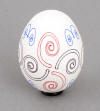|
ILLUSTRATED EGGS - THE EGG-BOT PROJECT This page shows about two dozen eggs illustrated using the Egg-Bot, a computer controlled plotter/printer which draws on curved surfaces. |
|
 First
dozen eggs shown in 3D anaglyph for viewing with RED/CYAN glasses. First
dozen eggs shown in 3D anaglyph for viewing with RED/CYAN glasses. |
 Second
dozen eggs shown in 3D anaglyph for viewing with RED/CYAN glasses. Second
dozen eggs shown in 3D anaglyph for viewing with RED/CYAN glasses. |
 Same
as above with numbers corresponding to the numbers of individual eggs
below. Some are shown also in 3D for anaglyph glasses. If there are two
pictures in the same box, the one on left is in 3D anaglyph. Same
as above with numbers corresponding to the numbers of individual eggs
below. Some are shown also in 3D for anaglyph glasses. If there are two
pictures in the same box, the one on left is in 3D anaglyph. |
 Same
as above with numbers corresponding to the numbers of individual eggs
below. Some are shown also in 3D for anaglyph glasses. If there are two
pictures in the same box, the one on left is in 3D anaglyph. Same
as above with numbers corresponding to the numbers of individual eggs
below. Some are shown also in 3D for anaglyph glasses. If there are two
pictures in the same box, the one on left is in 3D anaglyph. |
|
3-- |
|
 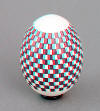 19
19 |
|
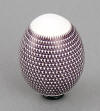 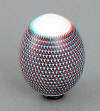 20
20 |
|
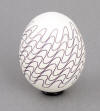  21
21 |
|
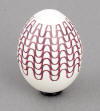 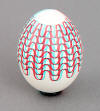 22
22 |
|
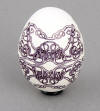  10
10 |
|
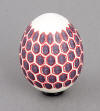 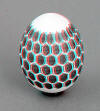 24
24 |
|
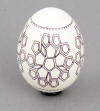 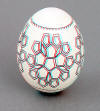 12
12 |
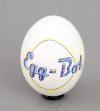 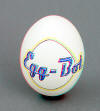 25
25 |
|
The Egg-Bot |
The software used to operate the Egg-Bot draws characters using outlines. As a result, it is not easy to create very small fonts. In order to alleviate this problem, I have created a primitive font composed of single strokes. It is not a real font, rather these are the illustrations of letters and numbers which must be copied and pasted one by one. |
|
The Egg-Bot plotter was introduced to the public in late 2010. I bought mine through the wonderful people at "Evil Mad Science" (http://evilmadscience.com/tinykitlist/171-egg-bot ) who are the distributors for this amazing new tool. For the last couple of months I have been having a blast creating intricate designs on eggshells that I prepare ahead of time. You can see some of my creations here. What fun. The Egg-Bot was invented by Bruce Shapiro in 1990 and has been in the process of perfecting since then and finally made into a practical device ready for use by the general public. You can read more about Bruce here: http://egg-bot.com/index.php?page=about The Egg-Bot is basically an X-Y plotter using readily available Sharpie or other similar pens as the drawing medium. The difference between a regular X-Y plotter and the Egg-Bot is that while an X-Y plotter draws on flat surfaces, the Egg-Bot does so on curved surfaces. In a regular plotter the two main driving motors use timing belts to convert circular to linear motion to move the pen back and forth on paper or other media. However in the Egg-Bot one motor is directly connected to the curved surface rotating it clockwise or ccw, while the other motor is connected to a swinging arm which holds the pen and swings back and forth in an arc. The diameter of the arc can is adjustable by the user, thus making it easy to draw on perfectly round or on egg-like (ovoid) shapes. The Egg-Bot is controlled via a USB cable and an external low voltage power. The Egg-Bot uses the free software application Inkspace with which one can generate designs and control the operation of the plotter. Inkscape is a free and open source application. (http://inkscape.org/ ) The application must be downloaded and installed on your computer before attempting to operate the plotter. One can draw on raw eggs or on eggshells which have been emptied of the content prior to that. Preparing the eggshells is a process that requires some time if you are fussy about their appearance. I will talk more about it separately. The designs are totally depended on your ability to create them. However, for beginners, there is a free source of some two dozen designs which one can download and use directly. After exhausting all the "free" designs, I started to create my own and managed to do some fantastically intricate designs. One can use Inkscape to create designs or other vector based software. Since I am well familiar with Adobe Illustrator, a mainstream illustrating software, I prepare the artwork there and import it to Inkscape for application on the eggs. |
|
| Back to the Serendipity page | |
